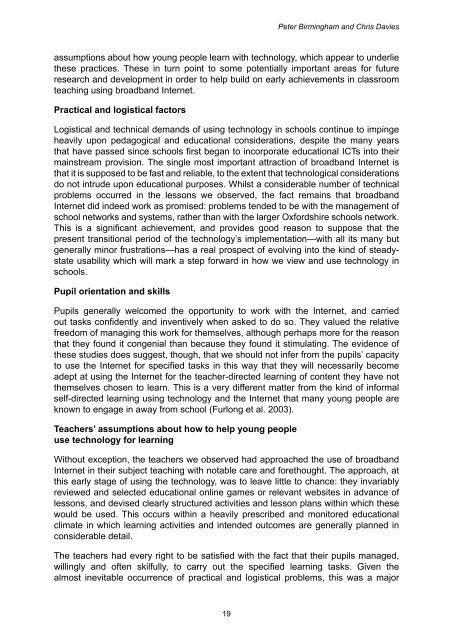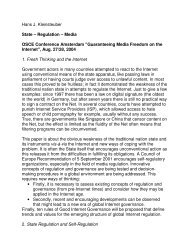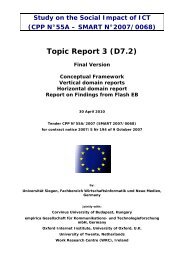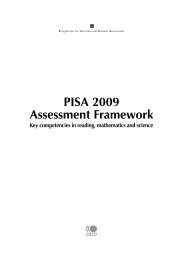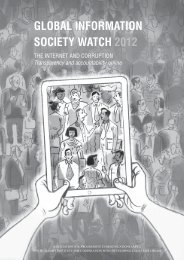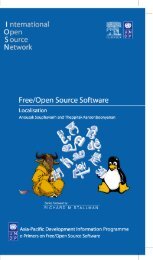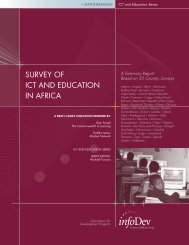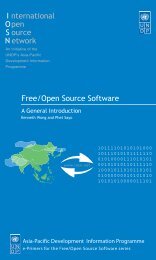Implementing broadband Internet in the classroom: key issues for ...
Implementing broadband Internet in the classroom: key issues for ...
Implementing broadband Internet in the classroom: key issues for ...
You also want an ePaper? Increase the reach of your titles
YUMPU automatically turns print PDFs into web optimized ePapers that Google loves.
Peter Birm<strong>in</strong>gham and Chris Daviesassumptions about how young people learn with technology, which appear to underlie<strong>the</strong>se practices. These <strong>in</strong> turn po<strong>in</strong>t to some potentially important areas <strong>for</strong> futureresearch and development <strong>in</strong> order to help build on early achievements <strong>in</strong> <strong>classroom</strong>teach<strong>in</strong>g us<strong>in</strong>g <strong>broadband</strong> <strong>Internet</strong>.Practical and logistical factorsLogistical and technical demands of us<strong>in</strong>g technology <strong>in</strong> schools cont<strong>in</strong>ue to imp<strong>in</strong>geheavily upon pedagogical and educational considerations, despite <strong>the</strong> many yearsthat have passed s<strong>in</strong>ce schools first began to <strong>in</strong>corporate educational ICTs <strong>in</strong>to <strong>the</strong>irma<strong>in</strong>stream provision. The s<strong>in</strong>gle most important attraction of <strong>broadband</strong> <strong>Internet</strong> isthat it is supposed to be fast and reliable, to <strong>the</strong> extent that technological considerationsdo not <strong>in</strong>trude upon educational purposes. Whilst a considerable number of technicalproblems occurred <strong>in</strong> <strong>the</strong> lessons we observed, <strong>the</strong> fact rema<strong>in</strong>s that <strong>broadband</strong><strong>Internet</strong> did <strong>in</strong>deed work as promised: problems tended to be with <strong>the</strong> management ofschool networks and systems, ra<strong>the</strong>r than with <strong>the</strong> larger Ox<strong>for</strong>dshire schools network.This is a significant achievement, and provides good reason to suppose that <strong>the</strong>present transitional period of <strong>the</strong> technology’s implementation—with all its many butgenerally m<strong>in</strong>or frustrations—has a real prospect of evolv<strong>in</strong>g <strong>in</strong>to <strong>the</strong> k<strong>in</strong>d of steadystateusability which will mark a step <strong>for</strong>ward <strong>in</strong> how we view and use technology <strong>in</strong>schools.Pupil orientation and skillsPupils generally welcomed <strong>the</strong> opportunity to work with <strong>the</strong> <strong>Internet</strong>, and carriedout tasks confidently and <strong>in</strong>ventively when asked to do so. They valued <strong>the</strong> relativefreedom of manag<strong>in</strong>g this work <strong>for</strong> <strong>the</strong>mselves, although perhaps more <strong>for</strong> <strong>the</strong> reasonthat <strong>the</strong>y found it congenial than because <strong>the</strong>y found it stimulat<strong>in</strong>g. The evidence of<strong>the</strong>se studies does suggest, though, that we should not <strong>in</strong>fer from <strong>the</strong> pupils’ capacityto use <strong>the</strong> <strong>Internet</strong> <strong>for</strong> specified tasks <strong>in</strong> this way that <strong>the</strong>y will necessarily becomeadept at us<strong>in</strong>g <strong>the</strong> <strong>Internet</strong> <strong>for</strong> <strong>the</strong> teacher-directed learn<strong>in</strong>g of content <strong>the</strong>y have not<strong>the</strong>mselves chosen to learn. This is a very different matter from <strong>the</strong> k<strong>in</strong>d of <strong>in</strong><strong>for</strong>malself-directed learn<strong>in</strong>g us<strong>in</strong>g technology and <strong>the</strong> <strong>Internet</strong> that many young people areknown to engage <strong>in</strong> away from school (Furlong et al. 2003).Teachers’ assumptions about how to help young peopleuse technology <strong>for</strong> learn<strong>in</strong>gWithout exception, <strong>the</strong> teachers we observed had approached <strong>the</strong> use of <strong>broadband</strong><strong>Internet</strong> <strong>in</strong> <strong>the</strong>ir subject teach<strong>in</strong>g with notable care and <strong>for</strong>ethought. The approach, atthis early stage of us<strong>in</strong>g <strong>the</strong> technology, was to leave little to chance: <strong>the</strong>y <strong>in</strong>variablyreviewed and selected educational onl<strong>in</strong>e games or relevant websites <strong>in</strong> advance oflessons, and devised clearly structured activities and lesson plans with<strong>in</strong> which <strong>the</strong>sewould be used. This occurs with<strong>in</strong> a heavily prescribed and monitored educationalclimate <strong>in</strong> which learn<strong>in</strong>g activities and <strong>in</strong>tended outcomes are generally planned <strong>in</strong>considerable detail.The teachers had every right to be satisfied with <strong>the</strong> fact that <strong>the</strong>ir pupils managed,will<strong>in</strong>gly and often skilfully, to carry out <strong>the</strong> specified learn<strong>in</strong>g tasks. Given <strong>the</strong>almost <strong>in</strong>evitable occurrence of practical and logistical problems, this was a major19


